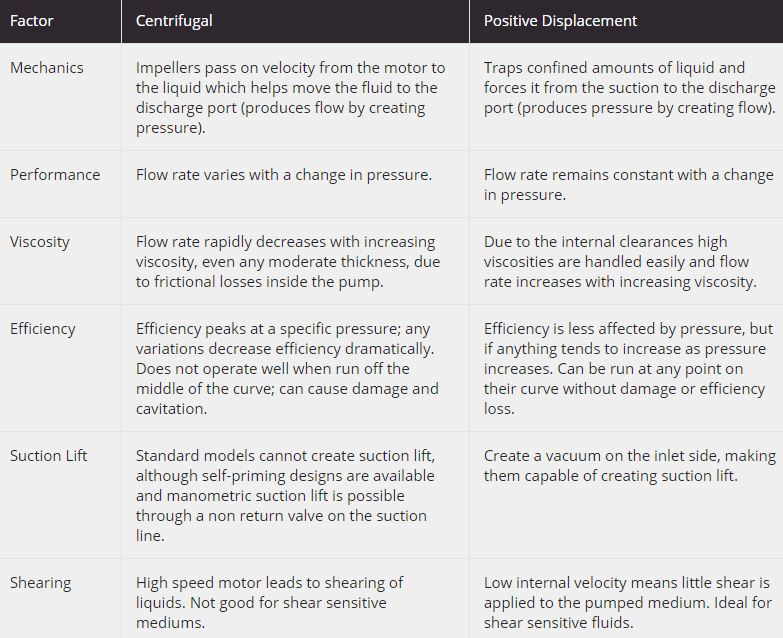Anderson Process offers a comprehensive line of centrifugal and positive displacement pumps to provide pump systems that deliver reliable performance in demanding applications. Although the basic structure and operation of pumping systems hasn’t changed much over the years, industrial pumps remain a sophisticated piece of machinery, each with its own ideal operating conditions and application. Understanding the difference between centrifugal and positive displacement pumps requires a great deal of specialized knowledge.
Centrifugal Pumps
Centrifugal pumps are the most commonly used pump type in the world. They’re designed for low-viscosity fluids that can tolerate high flow rates without risk of degradation. Centrifugal pump pressure is completely dependent on the changing flow, and transfers the kinetic energy of the motor to the liquid by a spinning impeller. An impeller rotates in the housing, reducing pressure at the inlet and bringing fluid to the outside of the centrifugal pumps housing, increasing the pressure enough to push it out of the discharge. Having a variable flow rate will move fluid at different speeds depending on pressure. These pumps are best for low pressure applications, but can be run in series to boost pressure. Lower viscosity fluid of up to 850 cSt do well in centrifugal pumps.
Centrifugal pump applications include commercial, industrial, residential and municipal. Some of these application may include air conditioning, irrigation, oil and energy, fuel transfer, water circulation, water supply and much more! They do well in simple applications like water pumped at 1,000 GPM with no back pressure.
Types of Centrifugal Pumps
- ANSI Process
- API
- Chopper
- Drum
- End Suction
- High Temperature
- Magnetically Driven
- Multistage
- Non-Metallic
- Recessed Impeller
- Sanitary
- Sealless
- Self-Primer
- Slurry
- Split Case
- Submersible
- Turbine
- Vertical
Brands
- Ampco Pumps Company
- Ansimag
- BJM Pumps
- Blackmer
- Dean Pump
- Finish Thompson
- Flux
- Goulds Water Technology
- Griswold
- Gusher Pumps
- Hayward Gordon
- Liquiflo
- March Pumps
- MTH Pumps
- Pioneer Pump
- Price Pump
- Richter
- Standard Pump
- Sundyne
- T-Mag
- Vanton
- Vertiflo
- Walrus
Positive Displacement Pumps
Positive displacement pumps are specifically engineered to provide consistent product transfer for even the most challenging media. These pumps will provide a continuous flow, more or less, regardless of the pressure. PD pumps move fluid by trapping a fixed volume, most commonly in a cavity, and then forcing that trapped fluid into the discharge pipe. PD pumps pull fluid into a compartment at the inlet and move it to an outlet for discharge using a rotary, reciprocating, or diaphragm method to move the fluid. Having a fixed flow rate will move fluid at the same speed regardless of pressure on the inlet. These pumps operate anywhere from 250 psi to 3,000 psi and gets more efficient in higher pressure. High viscosity fluids run more efficiently with lower energy costs in PD pumps.
PD pumps are used to transfer things like oil, sewage, slurry and pastes. They’re the best in the business when it comes to handling materials that contain a high volume of solids, such as groundwater and waste oils. PD pumps do well in complex applications like those involving suction lift.
Types of Positive Displacement Pumps
- Air-Operated Diaphragm (AOD)
- Drum
- Eccentric Disc
- Gear
- Hand
- High Temperature
- Lobe
- Magnetically Driven
- Metering
- Peristaltic
- Piston
- Plunger
- Progressive Cavity
- Sanitary
- Sealless
- Screw
- Vane
Brands
- All-Flo
- Almatec
- Ampco Pumps Company
- Blackmer
- BSM Pump Corporation
- CAT Pumps
- Continental Progressive Cavity Ultrapump
- Flowrox
- Flux
- FMC Technologies
- Graco
- Gusher Pumps
- Haight
- Hayward Gordon
- Liquiflo
- Mouvex
- Neptune
- Pulsafeeder
- Roto Pumps
- Standard Pump
- Tuthill
- Vogelsang
- Wilden

